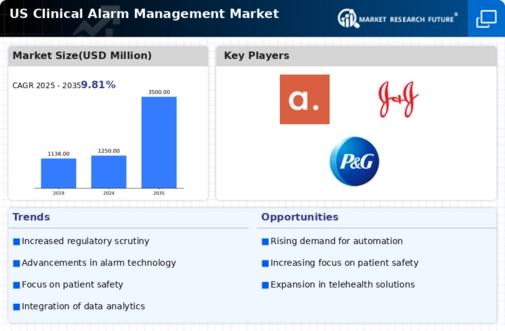Increasing Patient Safety Concerns
The clinical alarm-management market is experiencing growth driven by heightened concerns regarding patient safety. Hospitals and healthcare facilities are increasingly recognizing the need to mitigate alarm fatigue, which can lead to missed alerts and adverse patient outcomes. According to recent data, alarm-related incidents have been linked to approximately 80% of sentinel events in healthcare settings. This alarming statistic underscores the urgency for effective alarm management solutions. As a result, healthcare providers are investing in advanced alarm systems that prioritize critical alerts, thereby enhancing patient safety. The clinical alarm-management market is likely to expand as institutions seek to implement comprehensive strategies that address these safety concerns, ultimately leading to improved patient care and reduced liability risks.
Regulatory Pressures and Compliance
Regulatory pressures are significantly influencing the clinical alarm-management market. Healthcare organizations are required to comply with stringent regulations aimed at improving patient safety and reducing alarm-related incidents. The Joint Commission, for instance, has established standards that mandate the effective management of clinical alarms. Non-compliance can result in substantial financial penalties and reputational damage. As a result, healthcare facilities are compelled to invest in alarm management solutions that not only meet regulatory requirements but also enhance operational efficiency. The clinical alarm-management market is likely to see increased investment as organizations strive to align with these regulations, thereby fostering a culture of safety and accountability.
Integration of Advanced Technologies
The integration of advanced technologies into alarm systems is a key driver of the clinical alarm-management market. Innovations such as artificial intelligence (AI) and machine learning are being utilized to enhance alarm accuracy and reduce false positives. These technologies enable healthcare providers to analyze alarm data in real-time, allowing for more informed decision-making. For instance, AI algorithms can prioritize alarms based on patient condition, ensuring that critical alerts receive immediate attention. The market for clinical alarm-management solutions is projected to grow significantly, with estimates suggesting a compound annual growth rate (CAGR) of around 15% over the next five years. This growth reflects the increasing demand for sophisticated alarm systems that leverage technology to improve patient outcomes.
Focus on Cost Reduction and Efficiency
Cost reduction and operational efficiency are pivotal drivers in the clinical alarm-management market. Healthcare organizations are under constant pressure to optimize their resources while maintaining high standards of patient care. Effective alarm management systems can lead to significant cost savings by reducing alarm fatigue, minimizing unnecessary interventions, and improving staff workflow. Studies suggest that hospitals implementing advanced alarm management solutions can achieve up to a 30% reduction in alarm-related costs. This financial incentive is compelling healthcare providers to invest in technologies that streamline alarm processes and enhance overall efficiency. The clinical alarm-management market is likely to expand as organizations recognize the dual benefits of cost savings and improved patient outcomes.
Growing Demand for Interoperable Systems
The demand for interoperable alarm management systems is a significant driver in the clinical alarm-management market. As healthcare technology evolves, the need for systems that can seamlessly communicate with various medical devices becomes increasingly critical. Interoperability allows for the integration of alarms from different devices into a unified platform, reducing the risk of alarm fatigue and improving response times. According to industry estimates, approximately 70% of healthcare providers are seeking solutions that enhance interoperability. This trend indicates a shift towards comprehensive alarm management systems that can adapt to diverse healthcare environments. The clinical alarm-management market is poised for growth as providers prioritize solutions that facilitate interoperability and enhance patient care.

















Leave a Comment